
Tal Zaks (Moderna via YouTube)
For two decades, a new vaccine technology has been slowly approaching prime time. Now, can it stop a pandemic?
Two months before the outbreak, Moderna CMO Tal Zaks traveled from Cambridge, MA to Washington DC to meet with Anthony Fauci and the leaders of …
Sign up to read this article for free.
Get free access to a limited number of articles, plus choose newsletters to get straight to your inbox.